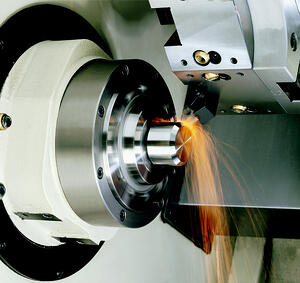6 Tips for Using Live Tooling
Posted by
Mike Williams on Thu, Apr 18, 2013
 Live tooling for CNC turning machines expands a manufacturer’s options by enabling off-center, secondary operations such as drilling, tapping, and end milling on the part face and around the diameter. As you might expect, there are a number of important considerations when adding live tooling to your existing CNC machines or including it in a new machine purchase. Here are 6 such points to think about.
Live tooling for CNC turning machines expands a manufacturer’s options by enabling off-center, secondary operations such as drilling, tapping, and end milling on the part face and around the diameter. As you might expect, there are a number of important considerations when adding live tooling to your existing CNC machines or including it in a new machine purchase. Here are 6 such points to think about.
- Turret Stations — If you are working with a 2-axis lathe, make sure you have enough turret stations for the total number of static and live tools required for your operations. Many 2-axis lathes have limited numbers of live stations, so it’s especially important to carefully consider your tooling needs.
- Coolants — If any of your processes require or could benefit from applying coolant through the live tooling, be sure the live tool holders you choose are plumbed for this purpose. It’s also important to determine if the live tooling is rated to withstand the amount of coolant pressure delivered by your machine. Working on many exotic alloys, for example, may require coolant pressures of 1,000 – 2,000 psi.
- Type of Axis — Standard lathes that support live tooling will perform drilling and milling only on the centerline of the X- and Z-axis. If you plan to perform off center operations, you will need a Y-axis.
- Number of Axes — You’ll need the appropriate number of X- and Z-axis live tool holders to match your requirements, along with tool clamping that matches the tool shank design.
- Interference — Adding the necessary number of static and live tools to the turret may create adjacent tool station interference with the workpiece, especially when facing to centerline on parts, especially those sized close to the maximum turning diameter of the machine.
- Relationships — C-axis accuracy is typically measured in arc seconds. It’s important to check part feature relationships, as C-axis positioning error increases when moving away from the spindle centerline. This means C-axis error could potentially use up all of your part feature location tolerances.
The experts at Gosiger can help you with these and many other issues regarding live tooling. Bring us your specific applications, and we’ll do the rest.